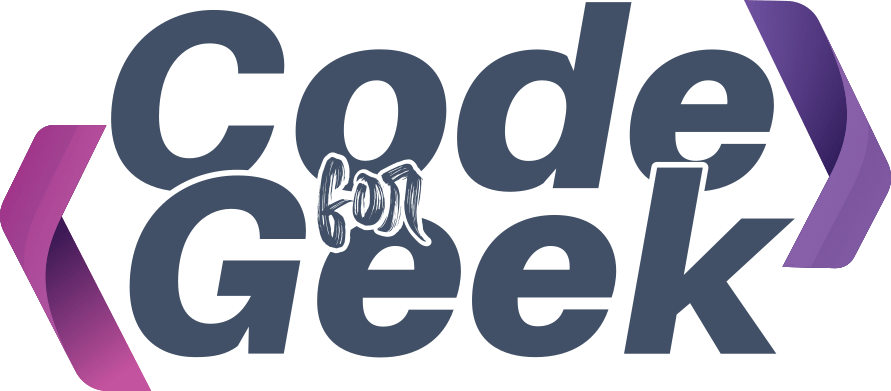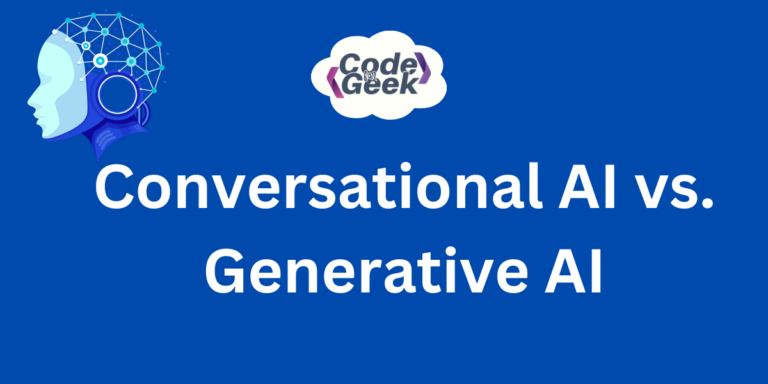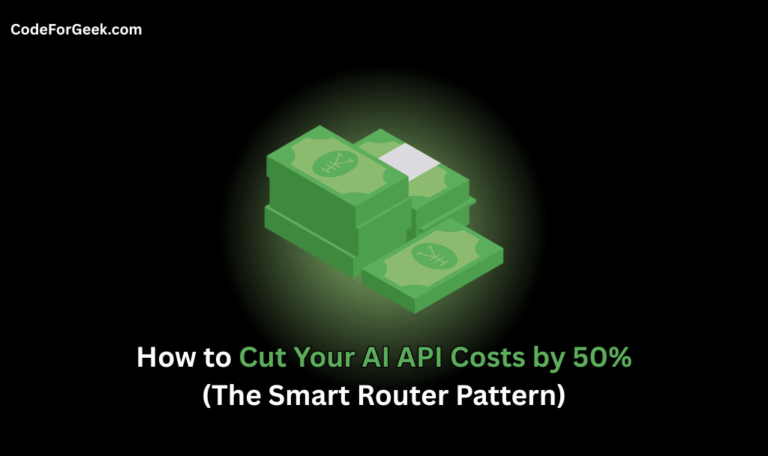Artificial Intelligence (AI) has come a long way over the past ten years. Two of the popular aspects of the technology are Conversational AI and Generative AI. While both belong to the field of AI, they operate differently and serve different purposes. In this article, we explain the concepts behind each form of AI in simple language.
What is Conversational AI?
Conversational AI is an emerging technology which enables computers to speak like a human. It implements techniques of natural language processing (NLP) and machine learning (ML) to decipher and respond to either spoken or typed words. It aims at designing systems capable of communicating with the user in a natural and effective way.
For example, we ask a question, “What’s the weather today?”. The AI breaks down our sentences to understand their meaning. It figures out what we want (e.g., weather updates). Then it pulls the answer from a database or predefined rules and shares the answer in a natural, human-like way.
Key Features of Conversational AI
Conversational AI models possess some features that enable them to perform well in communicating with users:
- Learnability: They keep getting better by learning from interactions, and this enables them to give more accurate and specific responses with time.
- Natural Language Understanding (NLU): They are able to comprehend human language. That is, they are able to determine what a user intends and extract meaningful information such as names, dates, or product types.
- Context Awareness: These systems can remember what was said before in a conversation, which helps them give better and more relevant answers.
- Real-Time Interaction: They reply quickly, providing near-instant feedback, which is crucial to maintaining the flow and spontaneity of the conversation.
- Multimodal Inputs: The majority of conversational AIs accommodate both text and voice inputs. This adaptability makes them efficient in a variety of settings.
How Does Conversational AI Work?
- Input Reception: The system takes input from the user in text or voice.
- Comprehension: It applies NLP algorithms to process the input and obtain meaning.
- Response Generation: The AI generates an appropriate response based on what it has learned.
- Learning: The AI learns with every interaction to improve its language proficiency based on feedback.
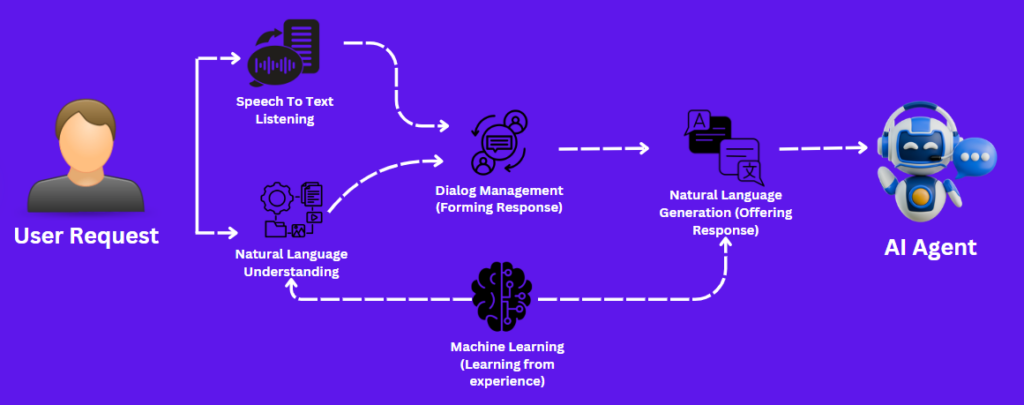
Top Use Cases of Conversational AI
- AI Customer Support: Most businesses employ chatbots to answer customer queries round-the-clock. This reduces wait time and makes customers contented.
- Virtual Personal Assistants: Voice assistants assist individuals in scheduling their daily calendars, managing smart home appliances, and even providing personalized recommendations.
- E-commerce: Shoppers are helped in product search, payment, and even recommended other relevant products.
- Healthcare: Virtual assistants schedule appointments, give basic health information, and give reminders for drug intake.
What is Generative AI?
Generative AI, by contrast, is entirely focused on producing new content. It’s beyond question-answering and chat, it exists to generate new information in the form of text, pictures, music, or even programming code. Such systems utilize complex machine learning algorithms—most typically in the guise of deep neural networks—to generate output that mirrors human imagination.
For example, we give a prompt saying “Write a poem about the ocean.”. The AI scans millions of poems to learn styles and structures. Then it generates a unique poem based on what it learned and shares the new creation.
Key Features of Generative AI
Generative AI also has some of its own unique characteristics:
- Content generation: It has an essential role in generating new content that is more creative and diverse in nature.
- Deep learning: It employs powerful neural networks in order to unlock subtle patterns from data, so that it may generate highly advanced outputs.
- Customization: This enables the user to provide prompts or directions, which can allow the AI to produce content that matches the instructions. This feature makes it exceptionally versatile for numerous creative applications.
- Scalability: Generative AI models may be scaled for generating large numbers of content instantly, which may be helpful to media, entertainment, and ad industries.
- Innovation: The outputs are more than simple replicas of the input information, they can combine things in new ways not imagined by human designers.
How Does Generative AI Work?
- Data Collection: The model is trained on a dataset, an extremely large one that could be of text, image, or anything in between.
- Pattern Learning: The model identifies patterns and structures inherent in the data.
- Generation Process: According to the prompt, it applies these patterns to generate new content that mimics the style and structure of training data.
- Output: The end result is a work of imagination that can be written to suit particular instructions or topics.
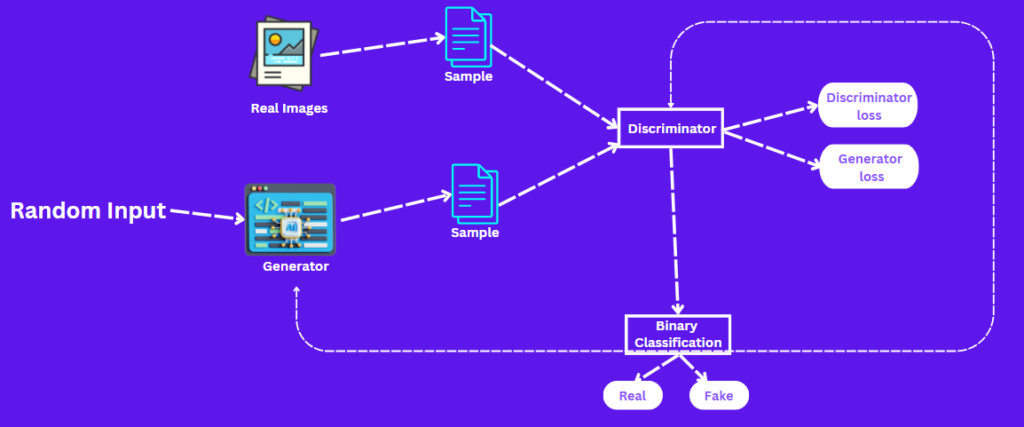
Top Use Cases of Generative AI
- Content Creation: Bloggers, journalists, and advertisers use generative AI to compose articles, create social media posts, or design creative ad copies.
- Graphic Design and Art: Generative AI can create logos, design campaign materials, and even help in video game design by creating backgrounds and characters.
- Music and Entertainment: Musicians use AI to generate new music, and movie producers could use generative techniques for special effects or for concepts in their storyboards.
- Programming: Developers are exploring AI-powered code generation, an initiative whose goal is to speed up software development through code suggestions and boilerplate code generation.
Conversational AI vs. Generative AI: Key Differences
| Aspect | Conversational AI | Generative AI |
| Primary Goal | Simulate natural conversation and provide interactive responses. | Create new, original content based on learned data patterns. |
| Core Technologies | Natural Language Processing (NLP), Machine Learning (ML). | Deep Learning, Neural Networks, Reinforcement Learning. |
| Main Outputs | Chat responses, voice commands, customer support messages. | Text, images, music, code, and other creative outputs. |
| Learning Process | Learns from previous interactions to improve context-based responses. | Trained on large datasets to learn patterns and generate creative outputs. |
| Interactivity | Focused on real-time, back-and-forth interaction with users. | Generally non-interactive, produces content based on prompts. |
| Use Cases | Customer service, virtual assistants, FAQ bots, voice search. | Content generation, art, music composition, creative writing. |
| User Input | Conversational queries, commands, and questions. | Prompts or guidelines that direct content creation. |
| Real-Time Adaptation | Responds instantly and adapts to conversation context. | Generates content after processing the prompt, not designed for instant dialogue. |
How Conversational AI and Generative AI Work Together
When Conversational AI and Generative AI team up, they combine the best of both worlds:
- Conversational AI manages the interaction (listening, clarifying, responding).
- Generative AI handles the creation (writing, designing, problem-solving).
Suppose this scenario: You type to a customer service chatbot, “Can you assist me in composing an email to complain about my late order?”
Step-by-Step Cooperation:
1. Conversational AI’s Role:
- Comprehends the Request: Applies Natural Language Processing (NLP) to recognize that you require assistance in writing an email.
- Asks Follow-Up Questions: May ask, “What is the order number, and why was it delayed?”
- Collects Context: Retrieves data like your tone (e.g., formal or informal) and arguments you need to make.
2. Generative AI’s Role:
- Creates the Email: Utilizes tools such as ChatGPT to create a well-written, courteous complaint letter from your input.
- Adds Personalization: Adds your order details and rewords the tone to match your tone (e.g., “I’m unhappy with the delay…”).
- Conversational AI’s Final Step: Sends the email draft and requests, “Do you want to edit this or send it as is?”
In Short:
- Conversational AI manages how the conversation goes (questions, context).
- Generative AI creates personalized and flexible content rather than universal templates.
Conclusion
In brief, both Conversational AI and Generative AI have bright futures in their own domains. Conversational AI is all about making dialogue natural and as if talking to a human being, while Generative AI uses creativity with data. With the right utilization of these technologies, businesses and artists can enjoy better productivity, better customer experiences, and a new age of digital innovation.
Conversational AI is your first choice for quick, interactive support, and Generative AI is the intelligent author of fresh content. Both are powerful but with distinct roles.
Remember:
- Use Conversational AI whenever you require assistance or solutions.
- Use Generative AI whenever you wish to create something new.
As AI keeps changing, knowing how to use these tools helps you use them better in work and life!
Here’s some more AI-related content you might find interesting:
- How to Use ChatGPT: All Basics Covered
- How to Write the Perfect ChatGPT Prompt: A 2024 Guide
- DeepSeek vs ChatGPT: Which Is the Best AI Chatbot in 2025?
